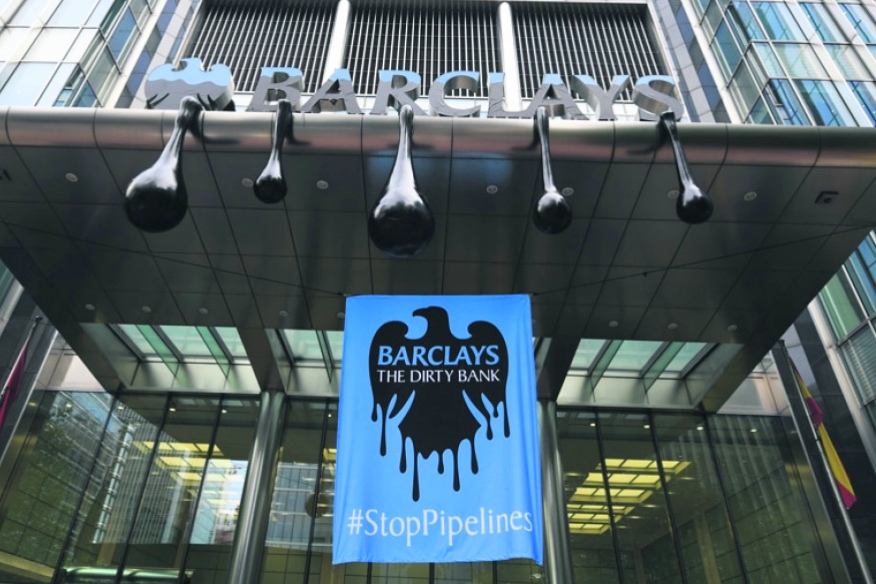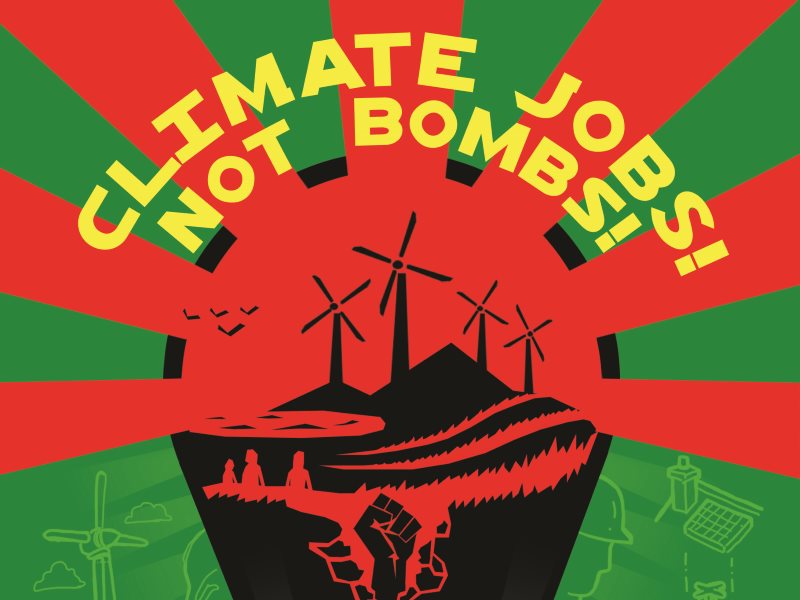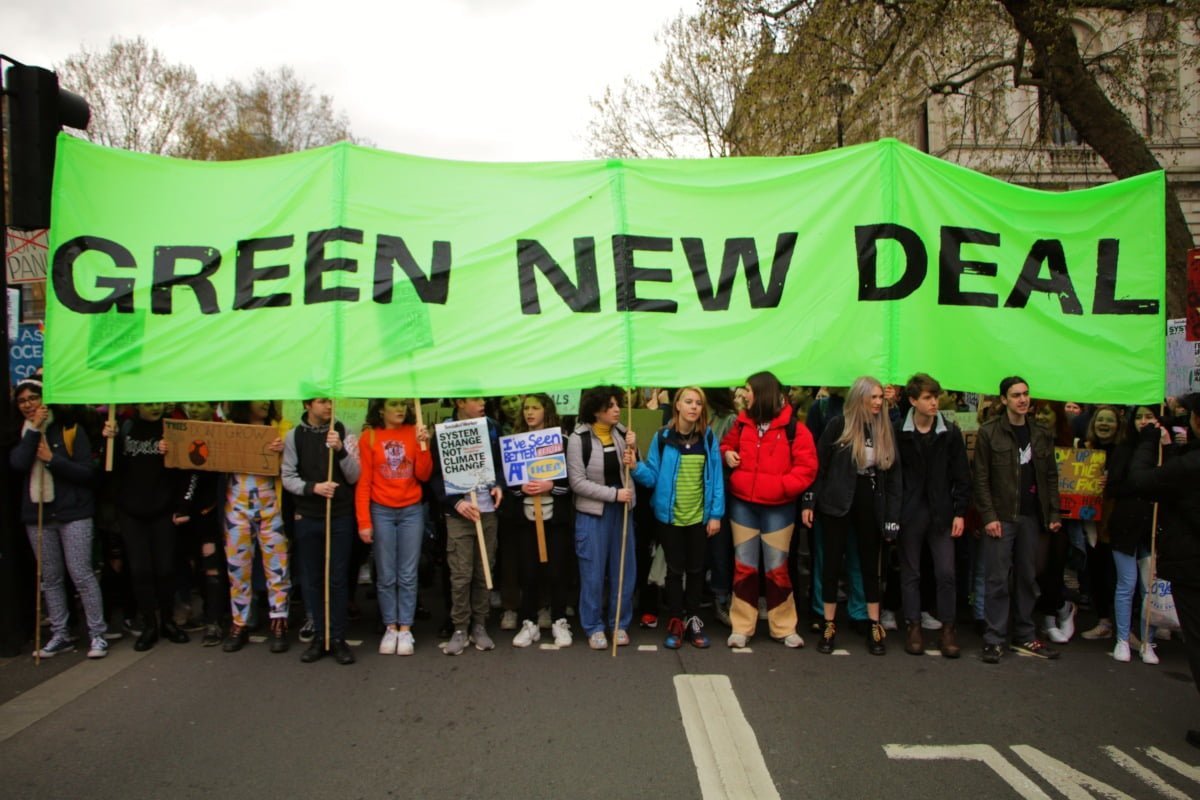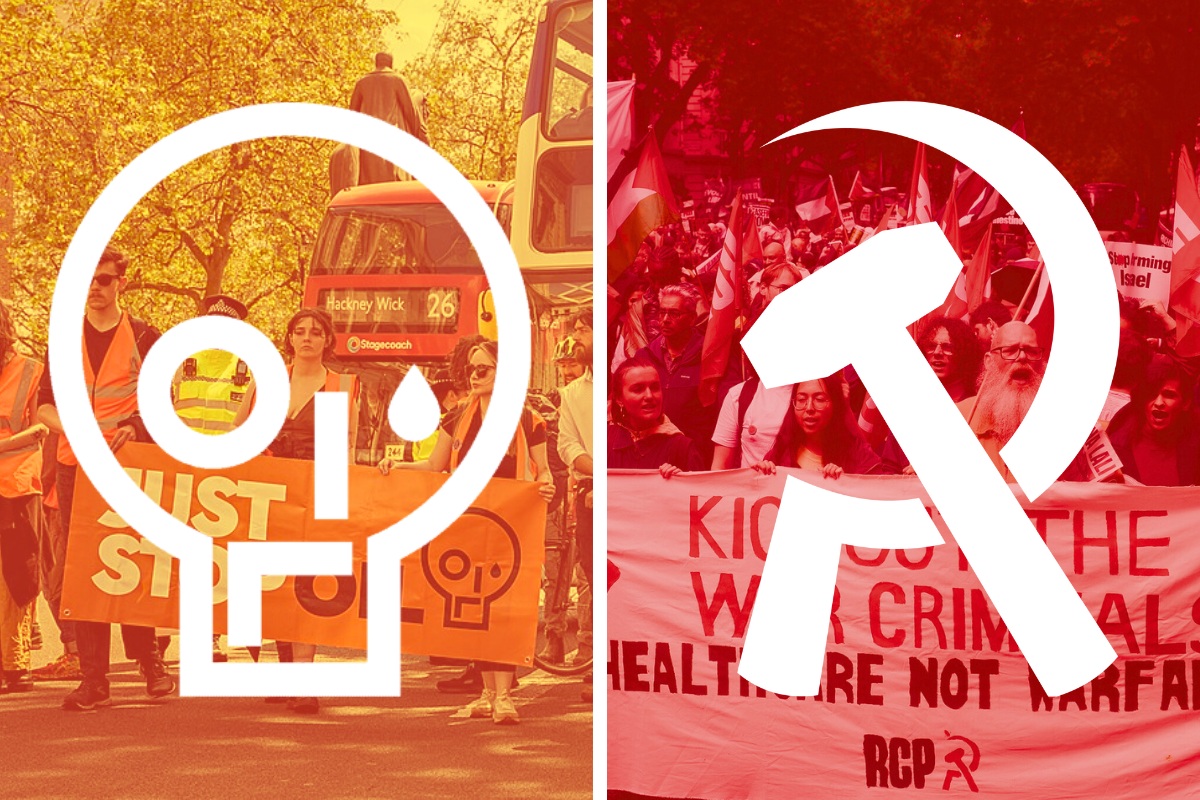Across the world, a new generation of activists is demanding urgent and radical action to stop climate change. But is the demand for a Green New Deal the solution to capitalism’s climate crisis?
The call for a Green New Deal has become increasingly prominent in recent months as part of the burgeoning international movement against climate change. It represents a welcome break from the liberal, individualistic attempts to address this crisis – pushed by the establishment – that have long dominated the debate.
By focusing on the need for wide-scale economic changes, the Green New Deal (GND) demand has connected with a newly radicalised layer of young people around the world. The most recent climate strike in London, for example, was led by a banner calling for such a policy, held high by a line of militant school students.
Radicalisation
 The GND proposal has been the centerpiece of the rising American left, most vocally championed by Alexandria Ocasio-Cortez (AOC), a leading figure from the Democratic Socialists of America, who was elected to Congress last year on a Democratic Party ticket.
The GND proposal has been the centerpiece of the rising American left, most vocally championed by Alexandria Ocasio-Cortez (AOC), a leading figure from the Democratic Socialists of America, who was elected to Congress last year on a Democratic Party ticket.
Earlier this year, on 7 February, Representative Ocasio-Cortez and Senator Markey presented a resolution outlining the principles of their Deal. These include: guaranteeing family-sustaining union jobs; accessible housing, education, clean water, clean air, healthy food; investment in infrastructure and overhauling transport; and stimulating clean domestic manufacturing industries.
Added to these environmental demands, AOC’s resolution also includes calls for the amelioration of current economic inequalities and reparation of historic injustices. But these are just aims – the policies to back it up are being delegated to a congressional committee, the creation of which is the only concrete proposal of the resolution.
Therefore, even in the midst of the media storm surrounding AOC and her proposal, what is actually being suggested is by no means clear – not least because those supporting the idea are politically heterogenous and not entirely certain themselves.
Nevertheless, AOC’s Green New Deal proposal has found a significant echo on the left. It is clear that after years of crisis, austerity, and inaction over climate change at the top, workers and youth are becoming increasingly radicalised politically, and are looking for bold solutions to the urgent economic and environmental problems facing society.
A class question
 The GND concept has since spread to the UK with the establishment of the Labour for a Green New Deal group in March.
The GND concept has since spread to the UK with the establishment of the Labour for a Green New Deal group in March.
The demands put forward by this campaign are a significant improvement on those of AOC. In their model motion for Labour conference, they call for “a green industrial revolution” that “[expands] public, democratic ownership as far as necessary for the transformation”. They also advocate the dismantling of the fossil fuel industry and replacing it with “clean, decent and socially useful work”.
The Labour leadership have already taken up this call, recently putting forward their own proposal for a ‘Green Industrial Revolution’. Just this week, Jeremy Corbyn announced that this would include steps to create a National Energy Agency, involving the nationalisation of Britain’s energy networks and public investment in solar panels for nearly two million homes.
These demands for public ownership and democratic control of the economy are far bolder and more class-based than anything raised in AOC’s resolution, which leaves the question of ownership open with phrases like, ‘appropriate ownership stakes’.
Above all, the Labour GND group’s mission statement stresses that “climate change is fundamentally a class issue”, and calls on the trade unions and Labour Party to play a leading role in the fight against climate change.
These bolder proposals reflect not only the growing demand for radical environmental and economic policies, but also the class nature of the parties that these different GND policies are aimed at. Whereas AOC’s resolution in the USA comes from within the Democratic Party, fundamentally a party of Wall Street and big business, the British variant is aimed at grassroots activists within the Corbyn movement and the unions.
System change
 The green movement has historically achieved very little. This is in no small part due to its isolation from the labour movement and its resultant dominance by apolitical – or in some cases outright reactionary – middle-class activists.
The green movement has historically achieved very little. This is in no small part due to its isolation from the labour movement and its resultant dominance by apolitical – or in some cases outright reactionary – middle-class activists.
In this respect, the premise of the Green New Deal marks an important step forwards. The demand provides much-needed political direction on the environmental question, emphasising that this is ultimately a class question that must be taken up by the labour movement.
The emergence of the student climate strikes, in particular, is politicising the green movement and blurring the lines between environmental and economic demands. The student strikes, for example, correctly demand “system change, not climate change”. Furthermore, the movement’s teenage founder, Greta Thunberg, has even backed calls for a general strike.
There is a growing recognition that radical systemic change is not just desirable but essential if we are to address both the economic and environmental crises. And the idea of the Green New Deal appeals because it claims to be able to kill these two birds with one stone – simultaneously addressing economic stagnation and inequality, and ecological destruction.
But at the present time, the GND slogan is still a bit of an empty bottle, capable of being filled with whatever content one desires. The GND’s aims – tackling the crisis of climate change, as well as capitalism’s austerity, poverty and exploitation – are not only correct but vital. However, revolutionary change is required to achieve these goals, and the leaders of the left have not yet reconciled themselves with this fact.
The thrust of the proposals currently being put forward on both sides of the Atlantic are fundamentally Keynesian in their content: advocating government-led investment in green technologies; funding these measures through taxation; and attempting to carry out these policies within the confines of the market and the profit system.
But taken to its logical conclusion, the struggle against climate change inevitably brings the capitalist system itself into question. This can be seen by the increasingly radical rhetoric on the subject in many recent articles in the mainstream media. One Guardian headline, for example, stated clearly that “ending climate change requires the end of capitalism”.
Keynesian policies, however, contradict this conclusion. Rather than offering “system change”, they seek to save the capitalist system from itself.
It is therefore vital that radical socialist demands are put forward as the only means by which the aims of the Green New Deal can genuinely be achieved.
Capitalism’s contradictions
 Economic and environmental crises are plain for all to see. But to understand them we must understand the system that gives rise to them.
Economic and environmental crises are plain for all to see. But to understand them we must understand the system that gives rise to them.
On the economic front, Marx explained how slumps and crashes are inherent within the capitalist system.
Under capitalism, the motor force of growth is investment. However, this investment will only be undertaken if it is profit-making. These profits come from the unpaid labour of the working class.
But the working class doesn’t just create the commodities that the capitalists attempt to sell (for a profit) – they also account for the lion’s share of consumption in terms of buying back the capitalists’ commodities. And since the working class only receives back a fraction of the value they produce in the form of wages, they cannot afford to buy all of the commodities that the system produces.
This is the essence of capitalism’s constantly re-emerging crises of overproduction. It is intrinsic within a system of private ownership and production for profit. The system’s ability to produce outstrips the narrow limits of the market.
This is reflected today in a whole host of contradictions: poverty amidst plenty; homelessness alongside empty homes; mass unemployment next to overwork; and austerity for the many whilst cash piles up in the hands of the few.
To kickstart the economy out of its current stupor, AOC and others want to go back to the old Keynesian method of government investment to ‘stimulate demand’ and ‘boost consumption’. Specifically, the aim is to tie this Keynesian stimulus to climate change using public investment in green industries and goods. But the (literal) trillion dollar question is: where will the cash come from?
The fact is that governments do not have any money of their own – they can only get it from borrowing, printing, or taxation. Taxes must come from either taxes on wages, thus cutting into the market; or taxes on profits, thus reducing the capitalist’s only incentive to invest in the first place. Taxation only ‘stimulates demand’, therefore, by suppressing it elsewhere.
The idea of borrowing to invest is also pregnant with problems. After all, which financiers are going to lend to a radical left government that is threatening to carry out large-scale nationalisations – i.e. expropriate private property? Besides which, debt-to-GDP levels in the US and elsewhere are currently at record peacetime levels.
AOC and advocates of ‘Modern Monetary Theory’ claim that this isn’t a problem as we can pay for it “the same way we paid for the original New Deal, World War II, the 2008 bank bailout” – that is, by the extension of credit from the Federal Reserve. In practice, this means the Federal Reserve ‘buying’ government bonds with non-existent money.
But printing money or expanding credit has inflationary effects, creating bubbles and instability that only delays the inevitable crisis of overproduction and deepens it when it finally does hit.
The lessons of the Great Depression and the fate of the original New Deal, implemented after the 1929 crash, offers a clear illustration of this fact. By 1937-38, following the New Deal, there was a renewed downturn as a result of a global turn towards protectionism and ‘beggar-thy-neighbour’ policies – that is, attempts to export the crisis elsewhere.
It is therefore a myth that the New Deal ‘saved’ capitalism. The real shift in fortunes for capitalism only came with the massive destruction of the means of production resulting from the Second World War, and the new opportunities for productive investment that this created. Only mass destruction of nightmarish proportions gave capitalism any room to breathe.
But even this could only last so long. By the mid-1970s crisis hit once again, as the contradictions of Keynesianism burst to the surface, with simultaneous economic slump and inflation. Capitalism only got out of that crisis by again making the working class pay. This was the meaning of Reaganism and Thatcherism. Economic misery and the environmental destruction we see today are the price we are paying to keep capitalism afloat.
The road to hell…
 The Keynesian idea behind the Green New Deal is that the government should stimulate demand through investment in ‘sustainable’ commodities, renewable energy infrastructure, the development of green technologies, and so on.
The Keynesian idea behind the Green New Deal is that the government should stimulate demand through investment in ‘sustainable’ commodities, renewable energy infrastructure, the development of green technologies, and so on.
It is 100% correct to say that we need to rapidly invest in green technologies, reduce energy demands, and curb emissions. But the real question that must be asked is: why have the capitalists not invested in these things to begin with? How, as a society, have we arrived at this knife edge in the first place, where the future of the planet hangs so delicately in the balance?
The answer, again, is that capitalism is production for profit – and genuine sustainability is not profitable. For instance, investment in housing insulation would reduce energy consumption, and thus cut into energy companies profits. Similarly, renewable energy technology, once installed, provides energy that is essentially free – in contrast to the super-profits of the fossil fuel cartels. The Saudi state oil monopoly, which is the most profitable company in the world, racked up profits of $111.1bn in 2018.
One hundred companies have been responsible for over 70% of greenhouse gas emissions in recent decades. We produce enough food to feed a population of 10 billion, yet according to the World Health Organisation over 820 million – that is 1 in 9 of a global population of 7 billion – went hungry in 2017. In the same year, the biggest three oil companies collectively made revenues of over $1 trillion.
These absurd contradictions only make sense in the context of a capitalist system in which production and distribution are entirely determined by profits. Under capitalism and the anarchy of the market, society’s needs – including the needs of our planet – will always be subordinate to the short-term profiteering interests of the bosses and bankers.
Even if today’s governments provided large-scale investment in green energy supplies, etc., the bulk of production would still be irrationally determined by the market and the insatiable appetite for profits. This would immediately come into conflict with any bold climate strategy.
Capitalism – regulated or otherwise – cannot guarantee housing, food, or clean air. Homelessness, hunger and air pollution appear nowhere on the capitalists’ ledgers. The continuation of pollution, inequality, and austerity is inevitable unless the profit motive is eliminated.
AOC and others may have good intentions about making capitalism “sustainable”. But the road to a very warm place is paved with such good intentions; in this case, that warm place is our planet.
We must therefore tell the truth: a Green New Deal – if it does not go beyond a Keynesian, capitalist basis – is doomed to fail, as it would not address the systemic contradictions that are responsible for the drastic problems that we now face.
Nationalise the banks
 On a socialist basis, however, we could achieve the GND demands and much more.
On a socialist basis, however, we could achieve the GND demands and much more.
Clearly the resources for such ambitious environmental transformation do exist. The fact is that there is already an incredible amount of wealth in existence. For example, it is estimated that over £700 billion – the equivalent of one third of UK GDP – lies uninvested in the vaults of the UK’s big banks. In the US, the figure stands closer to $2 trillion ($2000 billion) – and rising. The tech giant Apple, alone, sits on a cash mountain of over $200 billion.
This money sits idly in the bank accounts of big business because the bankers and bosses cannot find a profitable avenue for investment in the context of a saturated world market and a crisis-ridden global economy.
Instead of trying to entice the capitalists to invest against their interests, we need to take this money out of their hands. The only way to do this is through the nationalisation of the commanding heights of the economy – the key economic levers of the banks and major monopolies.
Momentum has called for banks to divest from fossil fuels, and shadow chancellor John McDonnell has proposed to delist companies from the London Stock Exchange that are not doing enough on climate change. But these kinds of proposals are insufficient.
In order to guarantee that the necessary steps are taken to stop climate change, the banks and big corporations must be expropriated and put under democratic control. Only in this way can we avoid the blackmail and threats of the capitalist class, and begin to plan the economy on the basis of need.
The demands put forward by Jeremy Corbyn and the Labour GND campaign for public ownership are correct. But this cannot be isolated simply to the transport and energy sectors. Instead of partial nationalisations – which leave the profit system intact (and prop it up) – what is required is a massive overhaul of all sectors of the economy, as part of a socialist plan, in order to rationalise production and utilise society’s resources in a harmonious and sustainable way.
The call for expropriation and a socialist plan of production go well beyond the scope of the Green New Deal as is currently being proposed in either the US or the UK. However, every day it is becoming clearer and clearer that capitalism cannot provide a way out of this environmental or economic crisis – and so the need for bold socialist change becomes clearer also.
Lessons from the Lucas Plan
 The need for the public ownership and democratic control of our economy is implied in AOC’s resolution, and is more explicitly stated by the Labour for a Green New Deal group. But neither go far enough in pointing the finger at the real culprit – the profit system – or putting forward the kind of concrete socialist demands that are required.
The need for the public ownership and democratic control of our economy is implied in AOC’s resolution, and is more explicitly stated by the Labour for a Green New Deal group. But neither go far enough in pointing the finger at the real culprit – the profit system – or putting forward the kind of concrete socialist demands that are required.
The closest thing we see in this respect is the demand from the Labour GND campaign for “a Lucas Plan for Britain”. The Lucas Plan was an incredibly detailed document created in the 1970s as an Alternative Corporate Plan by the workers of Lucas Aerospace, a UK arms manufacturer.
In the face of industrial decline, the Lucas Aerospace workers wanted to demonstrate that the weapons company could simultaneously avoid the redundancies that were threatened, and shift to the production of socially useful products. In over 1000 pages, they detailed around 150 products that they could manufacture, including kidney dialysis machines and renewable energy solutions.
But rather than implement the plan, the bosses chose to lay off 2000 workers, specifically targeting the leaders of the Shop Stewards Combine Committee who had taken the lead in organising the workers.
The history of the Lucas Plan contains important lessons on the question of ‘retooling’ the whole economy to make it environmentally sustainable: principally, that the ones who really know how to regear the economy are the workers themselves on the shopfloor.
The Lucas Plan only failed because the Labour leaders at the time were not bold enough to challenge the property rights of the owners. A socialist Labour government could have nationalised the factory and put it under democratic workers’ control, allowing the workers to carry out their progressive plan.
This is exactly the kind of dilemma that a Labour government today would face in attempting to implement a Green New Deal.
At the end of the day, you can’t plan what you don’t control; and you don’t control what you don’t own. If big business cannot make profits producing for social needs or providing secure, well-paid jobs, then they will not do so. As such, they must be nationalised.
Clause IV and common ownership
 Whilst both Ocasio-Cortez and Labour for a Green New Deal talk extensively about strengthening unions and collective bargaining, the case of the Lucas Plan also highlights the need for us to transform the unions into fighting, socialist organisations.
Whilst both Ocasio-Cortez and Labour for a Green New Deal talk extensively about strengthening unions and collective bargaining, the case of the Lucas Plan also highlights the need for us to transform the unions into fighting, socialist organisations.
The workers in Lucas Aerospace were led by the unofficial Combine Committee. But the TUC leaders largely abandoned the Lucas workers, considering their demands to be too militant and radical.
This same narrow outlook has been seen already in the reaction of American unions to the GND proposals. In March this year, the AFL-CIO – which comprises 55 unions and over 12 million workers – wrote to Ocasio-Cortez and Markey criticising the potential loss of jobs in certain industries that might occur as a result of a Green New Deal.
A similar problem of parochialism has been seen in the British trade unions in recent years, with unions such as GMB and Unite defending the giant waste of money that is the Trident nuclear weapons system, on the grounds that thousands of their members are employed in this socially useless project.
Whilst AOC’s resolution and the Labour GND campaign do call for the replacement of obsolete industrial sectors with union jobs in new sustainable industries, without a socialist plan of production it is impossible to guarantee this.
Of course, the need for an overall socialist plan is exactly the point that the union leaders should be making. The leaders of the labour movement must go further than demanding piecemeal nationalisation, and instead call for common ownership and workers’ control over the commanding heights of the economy.
This idea is not alien to our movement. Over 100 years ago, after all, the Labour Party pledged “to secure for the workers…the full fruits of their industry…on the basis of the common ownership of the means of production, distribution and exchange”.
This was the socialist commitment outlined in the original Clause IV of the Labour Party constitution, later removed by Tony Blair in 1995 as part of his New Labour project. Under Corbyn’s leadership, and with the Blairites in retreat, it is high time that we brought this historic pledge back and restored Clause IV to its rightful place.
Under a rational and democratic economic plan, in the hands of the working class, we could think ahead in terms of generations, instead of worrying about alleviating the short-term, hand-to-mouth crises of unemployment, homelessness, and poverty that capitalism creates.
Socialist revolution
 Corbyn’s Labour has responded to the mass environmental movements that have risen up in recent months, and have taken positive steps to provide these with a political programme. As part of this, for example, Labour has put out a call for a ‘Green Industrial Revolution’.
Corbyn’s Labour has responded to the mass environmental movements that have risen up in recent months, and have taken positive steps to provide these with a political programme. As part of this, for example, Labour has put out a call for a ‘Green Industrial Revolution’.
“Ultimately, tackling the environment and climate emergency,” shadow business secretary Rebecca Long-Bailey states, “will require the UK to reimagine its energy system, transport, agriculture, housing – its entire economy – so that it works for the many, not the few, long into the future.”
In summary, to stop climate change, we need a transformation of our economy on a scale not seen since the industrial revolution of the 18th and 19th centuries. This transformation was genuine and profound in a way that the New Deal wasn’t, leading to an enormous development of the productive forces especially in science, technology, and industry.
But this came at an enormous cost to society – both in terms of the brutal exploitation of workers, in the advanced capitalist countries and in the colonies; and, as we now recognise, in terms of environmental degradation also.
Most importantly, whilst capitalism was able to play a progressive role in its heyday, it has long since become a fetter on production. The barriers of private ownership and the nation state have become an enormous straightjacket on society. The continual investment and expansion that allowed capitalism to develop the productive forces in the past is no longer possible.
Instead, today, the system has broken down. Productivity growth has stalled. World trade and globalisation are slowing. Looking forward, even mainstream economists predict an era of ‘secular stagnation’.
The conditions for a new industrial revolution – green or otherwise – no longer exist under capitalism. At the same time, the problem is not technological or scientific; we already have the technologies and science required to solve the climate crisis. The problem is that capitalism cannot utilise these within the confines of the profit system.
The only way to end climate change and develop the productive forces going forward is by abolishing the capitalist system and replacing it with a socialist planned economy. We do not require a green industrial revolution – we need a socialist revolution.





